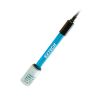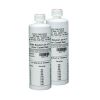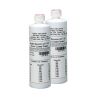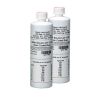Extech Waterproof pH Meter Kit
Features
- Automatic temperature compensation
- Memory stores up to 200 readings with series number
- Choice of 3 point calibration for better accuracy
- Free ground shipping
- Expedited repair and warranty service
- Lifetime technical support
- More
Overview
The Extech Waterproof pH/mV/Temperature Kit has a memory that stores up to 200 readings with series number, measured value, and temperature. Users have a choice of a 3-point calibration for better accuracy for pH 4, 7, and 10.
Benefits
- Waterproof housing (meets IP57)
- Automatic calibration (4, 7, and 10pH)
- Choice of 3 point calibration for better accuracy
- Automatic Temperature Compensation
- Memory stores up to 200 readings with series number, measured value and temperature
- Large blue backlit dual LCD display
- Auto power off saves battery life with disable function
- Complete with pH/mV/Temperature electrode, protective rubber holster, pH calibration solutions (4, 7, and 10pH), 2 AA batteries, and hard carrying case
- pH range: -2.00 to 19.99pH
- pH resolution: 0.01pH
- pH accuracy: ±0.02pH
- mV range: -1999 to + 1999mV
- mV resolution: 1mV
- mV accuracy: ±0.15mV
- Temperature range: 32 to 212°F (0 to 100°C)
- Temperature resolution: 0.1°
- Temperature accuracy: ±1°F/±0.5°C
- Power: two AA batteries
- Meter dimensions: 4.7 x 2.6 x 1.2" (120 x 65 x 31mm)
- Meter weigth: 6.3oz (180g)
- Kit dimensions: 14 x 10.75 x 3” (355.6 x 273 x 76.2mm)
- Kit weight: 2.9lbs (1.3kg)
- (1) pH 300 meter
- (1) pH/mV/temperature electrode
- (1) protective rubber holster
- (1) 50mL bottle of pH 4 buffer
- (1) 50mL bottle of pH 7 buffer
- (1) 50mL bottle of pH 10 buffer
- (2) AA batteries
- (1) Hard-sided carrying case
In The News
Ocean acidification: University of Washington's giant plastic bags help control research conditions
With oceans becoming more acidic worldwide, scientists are getting creative in designing experiments to study them. For example, one group at the University of Washington is using giant plastic bags to study ocean acidification. Each bag holds about 3,000 liters of seawater and sits in a cylinder-like cage for stability. The group at UW, made up of professors and students, is controlling carbon dioxide levels in the bags over a nearly three-week period, during which they are looking at the effects of increased acidity on organisms living near the San Juan Islands. “These mesocosms are a way to do a traditional experiment you might do in a lab or classroom,” said Jim Murray, professor of oceanography at the University of Washington.
Read MoreNOAA Alaska buoy network to monitor North Pacific ocean acidification
National Oceanic and Atmospheric Administration scientists detected signs of ocean acidification in the waters that hold the vulnerable and valuable fisheries of the North Pacific off the coast of Alaska, but they only had a snapshot of the action. “We know that in this place were important commercial and subsistence fisheries that could be at risk from ocean acidification,” said Jeremy Mathis, a NOAA Pacific Marine Environmental Laboratory researcher and professor at the University of Alaska Fairbanks. To understand how ocean acidification affects the North Pacific, NOAA scientists created a mooring network that collects constant in situ data on parameters contributing to acidification. They hope it will reveal seasonal trends and patterns left out by their snapshots.
Read MoreSource Water Monitoring in Albany, New York: Tracing Water Quality throughout Tributaries
Thousands of US cities pull their drinking water from natural source waters like reservoirs, rivers, and streams, making overall watershed health a key consideration for water providers. In Albany, New York, the Albany Department of Water and Water Supply delivers drinking water to over 100,000 residents as well as monitors and manages the larger drinking water supply watershed. Hannah Doherty, Environmental Specialist at the Albany Department of Water and Water Supply , spends her days working with a small team to monitor the drinking supply and the connected water bodies. Doherty explains, “We’re the first to encounter the water that ends up being the drinking water.
Read More














